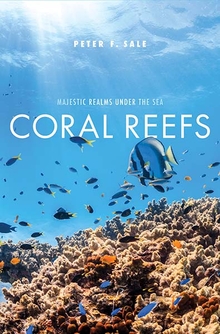Peter F. Sale—
Coral reefs are strewn across the tropical ocean like so many pearls from a broken necklace. Some are barely a few hundred meters from other reefs, but many are many kilometers from any other shallow water habitat. Yet nearly all the species that live on coral reefs spend the earliest part of their lives in a pelagic state: drifting in the plankton out on the open ocean. Some are pelagic only for hours, but most are pelagic for weeks or months, and some have rich pelagic lives lasting more than a year before they return to a reef to complete their lives. On return to a reef, some such as the corals promptly attach themselves to the substratum, never to move again. Others, like the fishes or crustaceans, retain their mobility, but become stick-in-the-mud creatures that never roam far for the rest of their lives. Why do they begin in the open ocean? How do they find their way back to reefs when the pelagic phase is nearing completion? These sound like simple questions, but they are not.

While the great majority of reef species have pelagic larvae, scientists know far more about the pelagic lives of fishes and their abilities to find their way back to reefs than they do about other types of reef creature. Reef fishes have pelagic lives from about 10 to 100 days in length, depending on the species, and the migration back to reef habitat is a brief, well-defined event in their lives rather than a process of slowly drifting back to shallow water as they age. As well, all larval reef fishes carry diaries in which they record how much growth they achieve for each day of life, and on which day they settle back to a reef. These diaries are tiny structures, otoliths, within the inner ear and scientists have learned how to read them. Other reef creatures lack these diaries, and this has impeded scientific study of their early lives.
The open ocean is a veritable desert with little food available for a small fish. The open ocean is swept by currents that can transport tiny fishes far from where they started. When you are floating in the ocean, far from land, there are very few cues to tell you where you are, how far you are drifting, whether any reefs are nearby, or even in what direction you are being transported by those currents. Such facts make the near universality of a pelagic larval phase a bit of a puzzle. Why begin life in a difficult habitat, only to be faced with the challenge of finding a suitable reef at the end of larval life? Of course, among the thousands of reef fish species, there are six or seven species that forego a pelagic existence, spending the whole of their lives in reef habitats. Those six or seven are a nuisance for scientists because if they can manage to be successful without going out to sea, why don’t many, or most, of the other species also stay at home?
It’s tempting to “explain” the pelagic larva as an evolutionary feature, and to assume that the return to reefs is an example of “innate” or “instinctive” behavior. Calling behavior innate or instinctive, ascribing its existence to the power of evolution, does not actually tell us very much about why or how it occurs. Fortunately, some scientists have worked diligently to find out more about the capabilities of larval reef fishes. Their stories form a 60-year-long skein of discoveries, beginning with Jack Randall’s 1955 observation that larval manini (a surgeonfish) actively swim against the tide to get into shallow waters the evening before they metamorphose from tiny, translucent, plankton-feeding, oceanic fishes into bottom-dwelling, pigmented, algae-grazing reef fishes. They don’t just drift until they blunder into suitable reef habitat!
Along the way, scientists have discovered that, by the end of their pelagic phase, reef fish larvae are very capable swimmers, can orient to the sound and the smell of distant coral reefs, can choose appropriate habitats within reefs in which to settle, and can settle preferentially near members of their own species. Reef fish larvae have been found to travel hundreds of kilometers from where they were spawned to where they eventually settle. Or they can return to settle very close to home. What we know of the larval lives of other reef creatures suggests that the fishes are likely typical—there is lots still to discover, and scientists can be certain to be surprised.
Of course, while these answers to “how” have enriched our understanding of reef fishes, revealing marvelous abilities for navigation over the vastness of the open ocean, we still do not have answers for “why.” And there remains that handful of species that avoid pelagic life that shouts out, “you don’t have to have a pelagic larval stage to be a successful reef species.” Just possibly, the widespread existence of pelagic larvae among reef species and the utter improbability of coral reefs themselves are bound together.
Peter F. Sale, a marine ecologist, is distinguished university professor emeritus at University of Windsor, Canada. He most recently served as senior advisor and assistant director for coastal projects for the United Nations University’s Institute for Water, Environment and Health. He blogs at www.petersalebooks.com, and tweets as @PeterSale3.
Further Reading:




 A New Audience for the World’s First Author
A New Audience for the World’s First Author